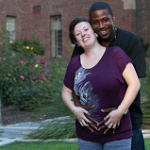A patient centered approach to safer conception: The BAPAC & PRO Men approach

- The CDC estimates there are 140,000 heterosexual, HIV-mixed status couples in the United States.
- Half of these mixed status couples desire children.
- Pregnancy increases both the risk of HIV transmission and acquisition.85% of HIV+ women report at least one unplanned pregnancy.
Preconception care and safer conception counseling offer a unique opportunity to embrace the reproductive health rights of HIV-affected couples while maximizing the health of both partners, preventing sexual and vertical HIV transmission, and preventing unplanned pregnancies.
While condoms have been the gold-standard HIV prevention method, when HIV-affected couples want to have a baby they must necessarily consider other options, weighing the risk of possible HIV transmission with their natural desires to have a child. Family building options for HIV-affected couples include adoption as such couples are not allowed to be denied this option. Either known donor or purchased sperm donation for HIV+ male/HIV- female couples carries zero risk of HIV transmission. HIV+ female/HIV- male couples can utilized home insemination to achieve pregnancy without risk of HIV transmission to the HIV- male partner. Assisted reproductive technologies, such as sperm washing combined with intrauterine insemination or in vitro-fertilization, have been offered to HIV-affected couples through some fertility clinics though the cost is high and the clinics that will work with such couples are few and far between.
However, data from recent clinical trials now offer additional options to dramatically reduce sexual HIV transmission, expanding the safer conception options available for HIV-affected couples.
First, HIV-positive individuals who take antiretroviral medications and have their virus fully suppressed reduce their risk of transmitting to a sex partner by 96%, a strategy known as treatment as prevention. Second, data from pre-exposure prophylaxis (PrEP) trials demonstrate HIV-negative individuals taking antiretrovirals is effective at can reduce their risk of acquiring HIV up to 100% when fully adherent to the medication. Based on these data, timed intercourse with or without PrEP provides effective, lower cost choices for HIV-affected couples trying to conceive. When engaged in care with a knowledgeable provider, HIV-affected couples are able to safely plan for a pregnancy where the HIV-affected partner and the infant remain HIV-negative.
Even with this tremendous news, HIV-affected couples experience stigma related to their fertility desires from friends, family, and medical providers. Many HIV-positive men in our UCSF Bay Area Perinatal AIDS Center’s PRO Men (Positive Reproductive Outcomes for HIV-positive Men) initiative, based at the San Francisco General Hospital Ward 86 HIV Clinic, report a desire to have a child. But they also say they’ve never been asked by their providers whether they want to have a child. In nearly every support group, one theme emerges: I just wish people understood. I wish people knew I can be like Magic Johnson. I wish people knew what we know about how to have a healthy sex life and family.
At Ward 86 HIV Clinic, all patients are asked at intake and then yearly about their current family make up and desire for children. The decision tree for engaging sexually active men and women in reproductive health topics guides clinicians toward resources for patients based on their current sexual partner(s) and reproductive health intentions. HIV+ men who have sex with women not currently desiring a child are provided information about contraception and HIV prevention methods.
The story has changed from one of risk reduction and permission giving to one of possibility and hope. It’s time our collective knowledge and attitudes caught up with the science. We’ve arrived at new point in the HIV epidemic – a compelling opportunity to support HIV-affected couples’ reproductive health desires, harnessing the behavioral and biomedical interventions toward the elimination of sexual HIV transmission.
——–Resources for patients & providers on HIV & pregnancy including videos and spanish/english brochures: http://hiv.ucsf.edu/care/perinatal.html
Shannon Weber, MSW
Director Perinatal HIV Hotline

